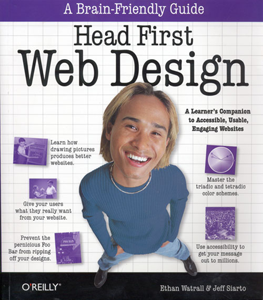
Head First Web Design: A Brain-Friendly Guide
Ethan Watrall & Jeff Siarto
O’Reilly Media
ISBN 978-0-596-52030-4, 495 pages
US $49.99, CN $49.99
“Uh-oh,” I thought, as I opened the package, “this is a very large book.” But a quick flip through revealed that there were plenty of illustrations, examples and exercises, and lots of white space. Not so much text to read at all.
I admit I’m a sucker for snappy book titles. How could anyone resist “Head First Web Design: a brain-friendly guide”? Would it live up to its title?
Let me state up front that this is a really useful book. Not madly inspirational, but definitely useful.
A while ago, in another book review, I mentioned contents pages which go on forever. This book’s Table of Contents occupies 13 pages! But it’s different. First there is the TOC (Summary) … just the bare basics. Then you get the TOC (the real thing). This latter expanded TOC is great. Each chapter begins with an explanatory paragraph followed by the list of subheadings. It works as an excellent overview of the whole book.
At this point, I must make a confession. I am not in the intended target audience for this book. In the Introduction I came to a section describing who the book is for. The following excerpt may help you decide if this book is for you:
If you can answer “yes” to all of these:
(My answers are in brackets)
1. Are you comfortable with XHTML & CSS but don’t have any experience with web design? (NO)
2. Do you consider yourself a web developer (working in a fun environment like PHP, Ruby on Rails, .NET) (NO)
3. Do you need to understand web design for a course, your line of work, or you simply want to impress people at parties with your vast knowledge of The Golden Ratio and the Web Content Accessibility Guidelines? (ER … I DON’T THINK SO)
this book is for you.
If you can answer “yes” to any of these:
1. Are you someone who doesn’t have any experience with HTML/XHTML & CSS. (YES)
2. Are you an accomplished web or graphic designer looking for a reference book. (NO/YES)
3. Are you someone who likes to build webpages with tools like Frontpage and Dreamweaver, so you don’t ever have to look at code? (I’D LIKE TO BE)
this book is not for you.
The truth is I am a graphic designer who is sometimes asked for advice about website design. I have designed only one website myself, which is not yet live. I have made no attempt to build a website, though some day I hope to produce one for myself, provided I have a techie on hand to fix any problems.
So, am I qualified to review this book? Hell yes. The book is about web design after all and I’m certainly able to judge whether sound design principles are being applied.
So here goes …
The Introduction focuses quite a bit on explaining why the authors’ approach is, indeed, brain-friendly. There’s some interesting information on how to “trick your brain into thinking that your life depends on knowing web design” so that it will remember what you learn in the book. Based on my knowledge of learning techniques (which I absorbed during my teaching years) I think it probably works.
My original intention was to read the book right through and do all, or most, of the exercises. but the authors’ number one piece of learning advice is to slow down. So in the interests of having the review done in less than a year I decided to do only a selection of the exercises. These exercises would be truly useful if you can resist the urge to cheat (the authors’ solutions are given on the following page, but I didn’t tell you that, did I!)
Each chapter uses a hypothetical website to take you through the process of developing the design. Emphasis is placed on user-centered design – meeting the needs of the client (something that graphic design professionals sometimes forget in their haste to produce glamorous designs).
You are advised to draw up a blueprint first, and to create a storyboard on paper before sitting at the computer, and certainly before doing any coding. I agree this should be done before the coding, but personally I can’t see any reason why the blueprint and storyboard can’t be done just as effectively on the computer. A graphic designer can produce classy sketches, but others might have nothing but messy scribbles to show the client, who might then be afraid the end result might be similar.
All the necessary elements are covered in the book: pre-production (very important); site organization; layout and design principles; use of color; navigation; writing for the web; accessibility; and more. There’s a useful chapter at the end on the business of web design. I especially liked the Appendix-Leftovers: The Top Ten things (we didn’t cover).
Head First Web Design is a book I intend to study more carefully, both for my own purposes and to give advice to clients.
The featured web designs may not be spectacular, but that’s appropriate for a book for non-designers, where a sound, functional, attractive-enough design is more relevant.
The style of the book is simple, down-to-earth, intelligent and witty. The exercises have substance. Anyone putting the recommendations into practice should end up with a nice-looking website that works.
Conclusion
Yes, definitely a brain-friendly guide.
MyMac.com rating: 4 out of 5
email – MyMac Magazine – Twitter – Advertise – Reviews Archive – Podcast

Leave a Reply
You must be logged in to post a comment.